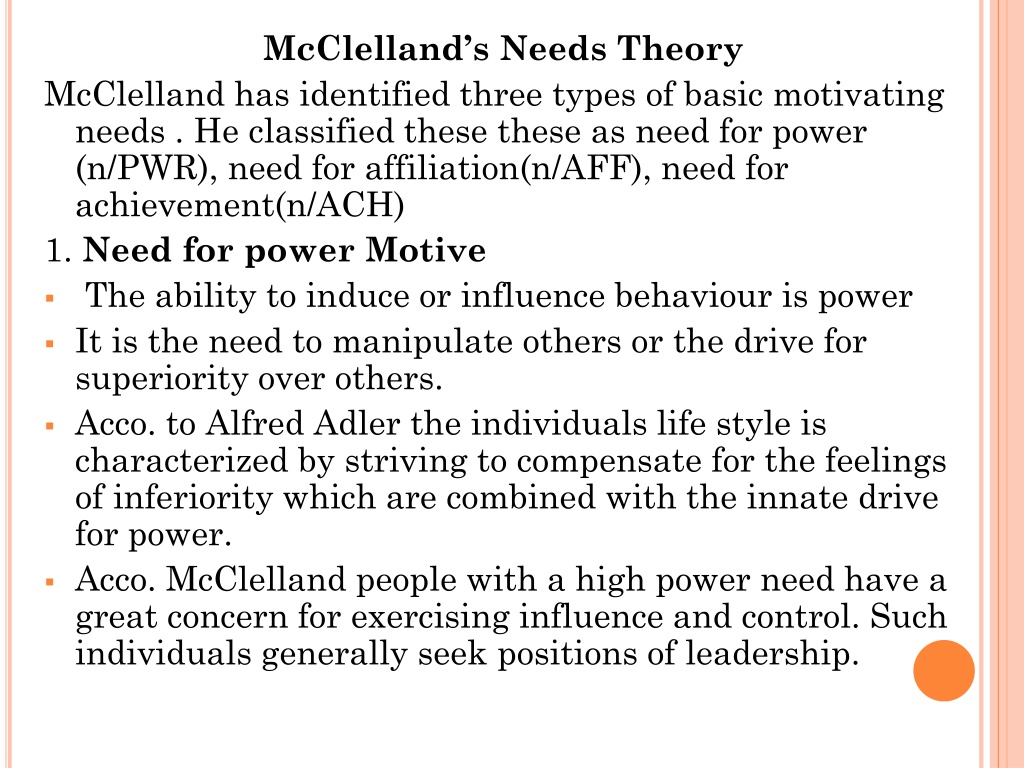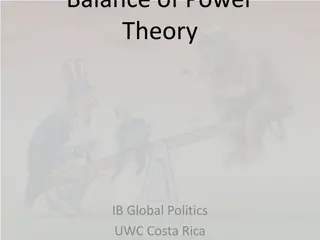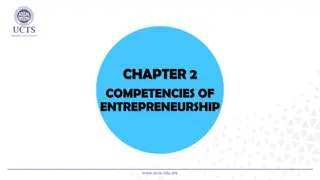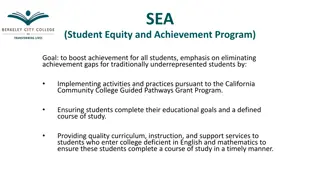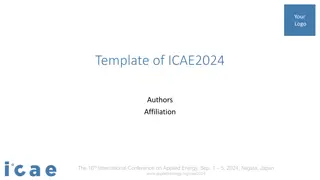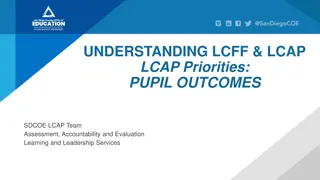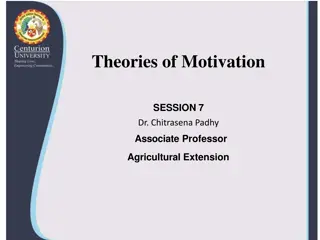Understanding McClelland's Needs Theory: Power, Affiliation, and Achievement
McClelland's Needs Theory identifies three fundamental motivating needs - power, affiliation, and achievement. Individuals with a high need for power seek influence and control, while those with a high need for affiliation prioritize social relationships. High achievers are characterized by moderate risk-taking, desire for immediate feedback, focus on accomplishment, and goal preoccupation. The theory has implications for organizational success and the development of achievement motives through training programs.
Download Presentation

Please find below an Image/Link to download the presentation.
The content on the website is provided AS IS for your information and personal use only. It may not be sold, licensed, or shared on other websites without obtaining consent from the author. Download presentation by click this link. If you encounter any issues during the download, it is possible that the publisher has removed the file from their server.
E N D
Presentation Transcript
McClellands Needs Theory McClelland has identified three types of basic motivating needs . He classified these these as need for power (n/PWR), need for affiliation(n/AFF), need for achievement(n/ACH) 1. Need for power Motive The ability to induce or influence behaviour is power It is the need to manipulate others or the drive for superiority over others. Acco. to Alfred Adler the individuals life style is characterized by striving to compensate for the feelings of inferiority which are combined with the innate drive for power. Acco. McClelland people with a high power need have a great concern for exercising influence and control. Such individuals generally seek positions of leadership.
They involve in conversation they are forceful, outspoken, hard headed, and demanding. Affiliation Motive : Most people like to interact with others in situation, where they feel, they belong and are accepted. People with high need for affiliation usually derive pleasure from being loved and tend to avoid the pain of being rejected. They are concerned with maintaining pleasant social relationship enjoy consoling and helping others in trouble. Achievement Motive: Achievement is a distinct motive that can be distinguished from other needs. McClelland identified four basic characteristics of high achievers.
Moderate risks: It is most descriptive characteristics of the person possessing high achievement needs. This is against the commonsense that high achiever would take high risks. 2. Immediate feed back: A person with high n/ACH desires activities which provide immediate and precise feedback information. How he is progressing towards the goal. 3. Accomplishment: A person with hish n/ACH does not expect material rewards. He likes earn a lot. 4. Preoccupation: Once a high achiever selects a goal , he tends to be totally preoccupied with the task until it is successfully completed . He put his maximum effort in completing the task. Acco to the reasearch conducted by the McClelland
The research indicates that the chief executives of smaller companies show higher achievement motive as compared to those of large companies. Simillarly middle level managers have high n/ACH as compared to the chief. Implications of the Theory: Achievement motivated people can be the backbone of most organisations bcz they progress much faster. Their success not only depend on their works but on the activities of others. Thus orgn. May need managers with varying degrees of achievement and affiliation motive. Achievement motive can be developed at early stage and also at later stage. Training programs were successful in increasing individual need for achievement .
It includes four primary goals. To teach participants how to think, talk, and eat like a person with high achievement. To stimulate participants to set higher but carefully planned realistic work goals over next two years. To give the participants knowledge about themsleves. To understand each other hopes and fears success and failures. It was found that after two years those person was promoted and expand their business faster than comparable men who had taken some other mgt. course. The implication is that training programmes may be added to develop achievement motive in inidividuals where it is needed.
Alderfers ERG Theory:He believes that there is a basic distinction b/w lower-order needs and higher-need orders. He has found that there is some overlapping b/w physiological security and social needs based on these observations. Alderfer has categorized the various needs into 3 categories . 1. Existense needs 2. Related needs 3. Growth needs 1. Existense needs: It include all the needs related to physiological safety aspect of an individual. 2. Relatedness needs: It includes all those needs that involve relationship with other people whom the individual cares.
Growth needs: It involves making creative efforts to achieve full potential in the existing environment. These include Maslow s self-actualisation need ie feeling of personal growth. ERG theory offers the following prepositions. As people move from focus on existense to relatedness and to growth needs the ways in which they can satisfy those needs become increasingly abstract. The individual is able to move to become productive, creative and as he moves to this level he sets highter goal for himself. People try to satisfy most concerete needs first then they move to abstract needs.
VROOMs Expectancy Theory Existing theories based on the needs of the people and their priority. Vroom has presented an alternative theory which is based on the motivation process. It has its roots in the cognitive concepts in the choice beahviour. Acco. to Vroom people will be motivated to do things to achieve some goals to the extent, that they expect that certain actions on their part will help them to achieve the goal. Vroom model is build around the concepts of value, expectancy and force. Motivation = Valence x Expectancy
Valence: Valence means strength of an individuals preference to a particular outcome.(incentive, attitude) The valence is positive for the individual he must prefer attending the outcome . If the valence zero occurs he is indifferent toward the outcome. Valence is negative individual prefers not attaining the outcome to attaining it. E.g Promotion In order to achieve promotion the first- outcome is superior, average, poor performance. Second-level outcome is promotion. The superior performance is being instrumental in obtaining promotion. Expectancy is the probability that a particular-first level outcome.
The strength of motivation to perform a certain act will depend on the sum of product of the values for the outcomes. Implications of the theory: It clarifies the relationship between individual and organisational goals. We can find the first-level outcomes(orgn objectives) second-level outcomes(worker goals) are how important to the employees for the attainment and the expectancies that are held to improve the ability to influence the first-level outcomes. This theory is consistent with the idea that manager s job is to design an environment for performance, by taking into account the differences in various situations. Porter-Lawer Model of Motivation Acco to porter-Lawer motivation model they propose a multi-variate model to explain the complex relationship that exists between job attitudes and job performance. This model encounters a positive relationship b/w satisfaction and performance.
The managers operate on the basis of some sort expectancies which, although based on previous experience ,are forward-oriented in a way that does not seem to be as easily handled by the habit of strength Elements of Porter-Lawer motivation model Effort Performance Rewards Satisfaction 1. Effort: Effort refers to the amount of energy exerted by an employee to a given task. 2. Performance: Effort leads to performance. If an individual has little ability or inaccurate role perception his performance may be ineffective. 1. 2. 3. 4.
3. Rewards: Intrinsic rewards are much more likely to produce attitudes about satisfaction that are related to performance. 4. Satisfaction: The actual rewards meet or exceed the perceived equitable rewards the individual feel satisfied otherwise he will dissatisfied. Implications Motivation is not a simple cause effect rather it is a complex phenomenon. The model suggest that managers should carefully asses their reward structure. Though careful planning effort performance-reward satisfaction should be integrated into an entire system of managing.
McGregors Theory of X and Theory of Y Acco to McGregor the basic assumption about human behaviour may differ bcz of complexity of factor influencing this behaviour. McGregor characterized these assumption in two oppposite point. Theory of X : assumptions are as follows. 1. Mgt. is responsible for organising elements of productive enterprises money, material, equipment, people. 2. With respect to people is the process of directing their efforts, motivating them, controlling their action, modifying their behaviour to fit the needs of the orgn. 3. Without active intervention by mgt. people would be passive to organisational needs. They must be persuaded, rewarded, punished, controlled and their activities must be directed (getting things done through others)
4. The average man in by nature work as little as possible. 5. He lacks ambition, dislikes responsibility prefers to be led. 6. He is inherently self-centered in different to organisational needs. 7. He is by nature resistant to change. 8. He is gullible not very bright. Managers subscribing these views about human nature attempt to structure, control and closely supervise their employees. Theory Y: The expenditure of physical and mental effort in work is natural depending on controllable conditions work may be a source of satisfaction or a source of punishment.
2. External control threat of punishment not only means toward organisational objectivities. Man will exercise self- control and self-direction of objectivities to which he is committed. 3. There may be reward associated with their achievement e.r Self-actualisation. 4. Avg human being learns under proper conditions not only to accept but to seek responsibility. Avoidance of responsibility lack of ambition and emphasis on security are generally consequences of experiences. 5. The capacity of exercise creativity in the solution of orgnisational problem distributed widely to the population. 6. The intellectual potentialities of avg human being are only partially utilised. Generally the Y theory assumption is that it emphasis on the co-operated Endeavour of mgt. and employees. Thus the employees which are in their best interest are also in the interest of organisation.
